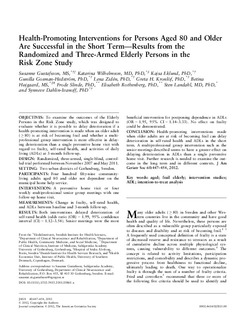| dc.contributor.author | Gustafsson, S. | |
| dc.contributor.author | Wilhelmson, K. | |
| dc.contributor.author | Eklund, K. | |
| dc.contributor.author | Gosman-Hedström, G. | |
| dc.contributor.author | Zidén, L. | |
| dc.contributor.author | Kronlöf, G.H. | |
| dc.contributor.author | Dahlin-Ivanoff, S. | |
| dc.date.accessioned | 2018-01-17T13:12:43Z | |
| dc.date.available | 2018-01-17T13:12:43Z | |
| dc.date.issued | 2012 | |
| dc.identifier.citation | Gustafsson, S., Wilhelmson, K., Eklund, K., Gosman-Hedström, G., Zidén, L., Kronlöf, G.H., . . . Dahlin-Ivanoff, S. (2012) Health-promoting interventions for persons aged 80 and older are successful in the short term--results from the randomized and three-armed Elderly Persons in the Risk Zone study. Journal of the American Geriatrics Society, 60(3), 447. | nb_NO |
| dc.identifier.uri | http://hdl.handle.net/11250/2477978 | |
| dc.description.abstract | Objectives: To examine the outcomes of the Elderly Persons in the Risk Zone study, which was designed to evaluate whether it is possible to delay deterioration if a health-promoting intervention is made when an older adult (=80) is at risk of becoming frail and whether a multiprofessional group intervention is more effective in delaying deterioration than a single preventive home visit with regard to frailty, self-rated health, and activities of daily living (ADLs) at 3-month follow-up. Design: Randomized, three-armed, single-blind, controlled trial performed between November 2007 and May 2011. Setting: Two urban districts of Gothenburg, Sweden. Participants: Four hundred fifty-nine community-living adults aged 80 and older not dependent on the municipal home help service. Intervention: A preventive home visit or four weekly multiprofessional senior group meetings with one follow-up home visit. Measurements: Change in frailty, self-rated health, and ADLs between baseline and 3-month follow-up. Results: Both interventions delayed deterioration of self-rated health (odds ratio (OR) = 1.99, 95% confidence interval (CI) = 1.12–3.54). Senior meetings were the most beneficial intervention for postponing dependence in ADLs (OR = 1.95, 95% CI = 1.14–3.33). No effect on frailty could be demonstrated. Conclusion: Health-promoting interventions made when older adults are at risk of becoming frail can delay deterioration in self-rated health and ADLs in the short term. A multiprofessional group intervention such as the senior meetings described seems to have a greater effect on delaying deterioration in ADLs than a single preventive home visit. Further research is needed to examine the outcome in the long term and in different contexts. | nb_NO |
| dc.publisher | Journal of the American Geriatrics Society | nb_NO |
| dc.subject | aged | nb_NO |
| dc.subject | frail elderly | nb_NO |
| dc.subject | intervention studies | nb_NO |
| dc.subject | ADL | nb_NO |
| dc.subject | intention-to-treat analysis | nb_NO |
| dc.title | Health-promoting interventions for persons aged 80 and older are successful in the short term-results from the randomized and three-armed Elderly Persons in the Risk Zone study | nb_NO |
| dc.type | Journal article | nb_NO |
| dc.source.pagenumber | 447 | nb_NO |
| dc.source.volume | 60 | nb_NO |
| dc.source.journal | Journal of the American Geriatrics Society | nb_NO |
| dc.source.issue | 3 | nb_NO |
| dc.identifier.doi | 10.1111/j.1532-5415.2011.03861.x | |
